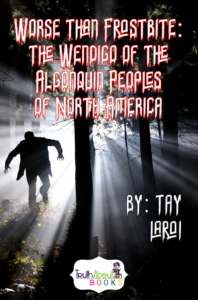 Among the Algonquian peoples of northeastern North America lurks a creature that waits for the ice and snow of winter to stalk its prey. It creeps in the cold shadows, looking for its next meal or for a lost soul to turn into one of its own. While the creature’s name and physical description varies among tribes, it is most commonly known as the Wendigo and there are several things that everyone can agree on: it is big, it is nasty, and it is hungry.
Among the Algonquian peoples of northeastern North America lurks a creature that waits for the ice and snow of winter to stalk its prey. It creeps in the cold shadows, looking for its next meal or for a lost soul to turn into one of its own. While the creature’s name and physical description varies among tribes, it is most commonly known as the Wendigo and there are several things that everyone can agree on: it is big, it is nasty, and it is hungry.
The Wendigo is said to be a cannibalistic evil spirit looking for travelers who lose their way due to the severe and ever-changing winter of its forest home. Due to its enormous size and the sacristy of victims the Wendigo is never satisfied, no matter much it eats. Its constant hunger has made its existence a cautionary tale against excessive greed and gluttony in addition to being a creature that haunts the woods.
Probably the best discription of the Wendigo comes from Basil Johnson, an Ojibwe teacher and scholar from Ontario. He describes the Wendigo as, “gaunt to the point of emaciation…its complexion the ash gray of death, and its eyes pushed back deep into their sockets…What lips it had were tattered and bloody [and it] gave off the strange and eerie odor of decay and decomposition, of death and corruption.” That doesn’t sound like something I’d want to meet in the woods.
Even if you’re lucky enough to avoid the Wendigo in the winter months, it’s still best to use caution while traveling. What if your car breaks down in the middle of a snow storm and you don’t have the proper clothing to go get help? What if you find yourself trapped, maybe for days? What if your travel companion starts looking pretty tasty? If the temptation proves to be too much, you just might find yourself turning into a Wendigo.
Good thing for an abundance of gas stations these days, eh?
Alternatively, it’s said that anyone who becomes too greedy and self-serving is at risk for becoming possessed by a Wendigo. While you won’t look like the nasty creature that Johnson describes, sharing head space with such a nasty creature doesn’t sound any more enjoyable.
With the morals tied to Wendigo’s existence, both the culturally specific one about cannibalism as well as the universal one about greed, it’s easy to brush the Wendigo as a simple story used to teach a lesson, even with its apparent sighting. But the Wendigo has a few added dimensions to its tale. Much like the demons of Western Christianity, the Wendigo has had nasty influences on communities over the years, even if it doesn’t leave behind physical signs.
At the beginning of the 20th Century, Jack Fiddler, a member of the Cree tribe, was tried for the murder of a woman he claims was possessed by a Wendigo. According to his testimony, Fiddler killed 14 creatures before he was finally arrested. Some years before Fiddler’s case, a man named Swift Runner reportedly killed and ate his family during a particularly nasty Alberta winter.
Unlike most of these other monsters, many of you are probably safe from the Wendigo. Even if you live within its borders, winter is still some time away, despite the snow that might fall in October. However, I still encourage caution. Between all the candy, treats, and other indulgences of the season, Halloween is a holiday famous for its excess and gluttony. I’d hate to hear of anyone turning into the first candy-based Wendigo.

